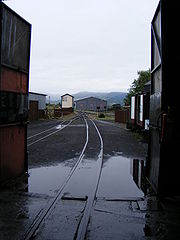
Gelert's Farm Works
Encyclopedia

History
After the WHR(P) purchased Beddgelert Siding in 1975 from British RailBritish Rail
British Railways , which from 1965 traded as British Rail, was the operator of most of the rail transport in Great Britain between 1948 and 1997. It was formed from the nationalisation of the "Big Four" British railway companies and lasted until the gradual privatisation of British Rail, in stages...
the ramshackle collection of farm buildings known as Gelert's Farm came up for sale. The farm which is situated between Beddgelert Siding and the Cambrian line and was purchased to become the operating centre for the rebuilt WHR
Welsh Highland Railway restoration
The restoration of Welsh Highland Railway has a colourful and complex history. This article provides the modern history:-The Background of the Welsh Highland Railway :...
. After possession of the land was obtained in late 1975 track was laid into the site. Over the next couple of years five sidings were laid into the yard and another back towards Pen-y-Mount
Pen-y-Mount railway station
Pen-y-Mount Junction station is the northern terminus of the Welsh Highland Heritage Railway. It opened on the 2 August 1980 at which time it consisted of a single platform with a run round loop and was intended to be a temporary terminus....
. The old hay barn was converted into a Loco shed and a large pole barn became the Carriage Shed. The stone buildings were converted to workshops and a machine shop.
In 1985 the area between the Carriage Shed and the WHR(P) main line was cleared and the Big Shed (100ft by 40ft) was constructed. The now vacant Carriage Shed was taken over by the Civil Engineer's Dept and renamed the Civvies Shed. The yard was remodelled giving four roads (No's 1-4) in the Big Shed, two roads into the Civvies Shed (No's 5&6), one road into the Loco Shed (No 7) and a siding (No 8) alongside the Loco Shed.
The next major development was the construction of the RED Shed north of the main yard alongside Farm Junction. This was in an area of the site known as the Old Man's Area. Between 1990 and 1993 a new shed (60ft by 30ft) was constructed and fitted out by the Railway Extension Department. Three Sidings (No's A-C) were laid into the new RED Shed (painted grey) and another siding (No D) was laid alongside the RED Shed. Access was gained from a half lead on No 8 road alongside the Loco Shed. During this period the shunting neck parallel to the main line was extended to the site of the old trans shipment Wharf where two sidings were laid.
By 2003 the WHR(P) had decided that its future lay in becoming the heritage centre for the entire WHR. It was realised that more covered accommodation, workshop space and sidings would be needed over the next ten years. The Civvies Shed had ceased to be used as a workshop, had become a depository for junk and was in imminent danger of collapse. In August 2003 a new siding (No 9)was laid into the cleared eastern bay of the shed for use as a Wagon repair shop. Over the next six months the roof was repaired and most of the floor concreted. The renamed Carriage & Wagon Workshop (C&W Shop) is now back in use, building and repairing both carriages and wagons.
During June 2005 the north west corner of the C&W Shop was dismantled. Once month later during the WHR(P)'s annual Civil's Week the trackwork in front of the Shed was rearranged with two half leads, this resulting in a new siding between the Big Shed and the C&W Shop. The new siding was numbered No 5. The two sidings into the C&W Shop were renumbered No's 6&7. The Loco Shed road was renumbered No 8 and the old No 8 became No 10. Over the Christmas
Christmas
Christmas or Christmas Day is an annual holiday generally celebrated on December 25 by billions of people around the world. It is a Christian feast that commemorates the birth of Jesus Christ, liturgically closing the Advent season and initiating the season of Christmastide, which lasts twelve days...
holiday No 5 road was extended between the two sheds and alongside the exhibition area. Eventually a new shed (3.4.5 Shed) will cover the exhibition area with No's 3&4 roads extended through the back of the Big Shed alongside No 5 road. No 6 road was severed alongside the Loco Stores and then slewed 8ft towards the Joiners Shop and extended 80ft towards the Cambrian Line
Cambrian Line
The Cambrian Line is a railway from Shrewsbury to Welshpool, Aberystwyth and Pwllheli. The railway runs first through the central part of Wales and then along the coast of Cardigan Bay....
. A concrete pad 45ft by 10ft was laid at the end of the siding for the new Diesel Shed.

